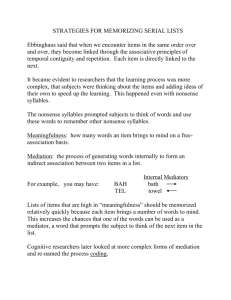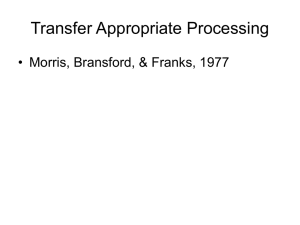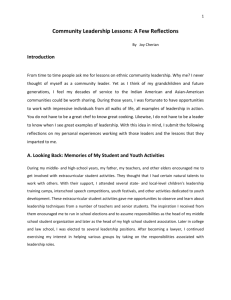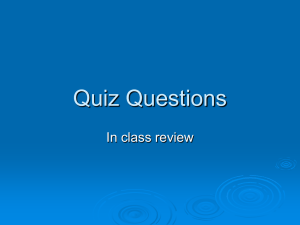References
advertisement
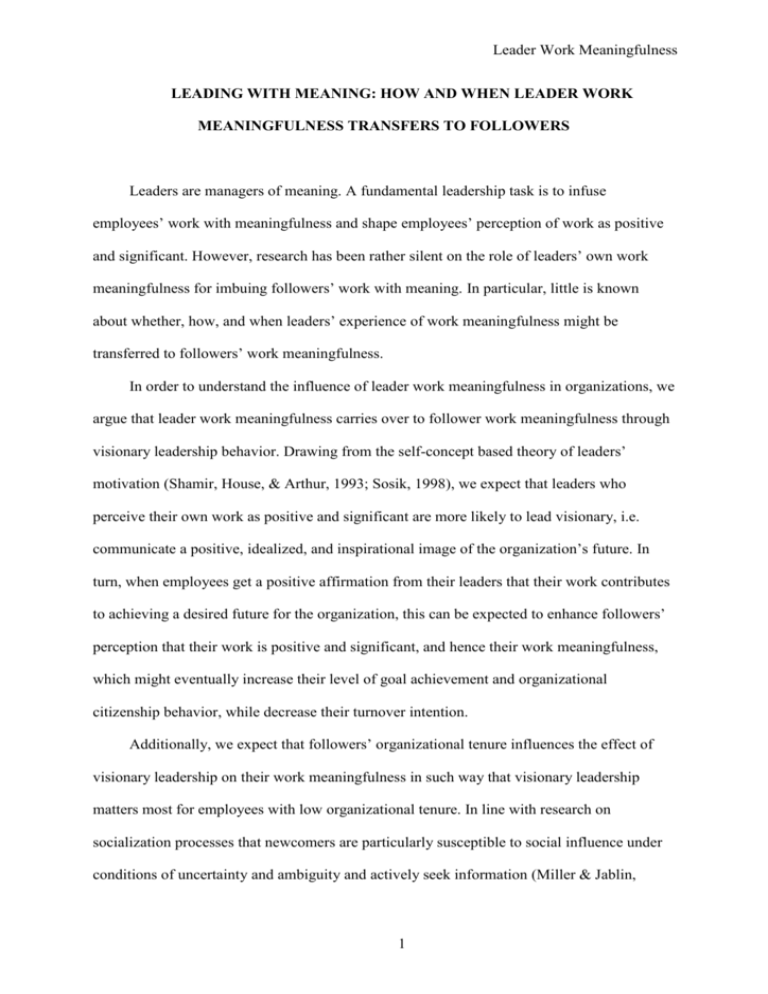
Leader Work Meaningfulness LEADING WITH MEANING: HOW AND WHEN LEADER WORK MEANINGFULNESS TRANSFERS TO FOLLOWERS Leaders are managers of meaning. A fundamental leadership task is to infuse employees’ work with meaningfulness and shape employees’ perception of work as positive and significant. However, research has been rather silent on the role of leaders’ own work meaningfulness for imbuing followers’ work with meaning. In particular, little is known about whether, how, and when leaders’ experience of work meaningfulness might be transferred to followers’ work meaningfulness. In order to understand the influence of leader work meaningfulness in organizations, we argue that leader work meaningfulness carries over to follower work meaningfulness through visionary leadership behavior. Drawing from the self-concept based theory of leaders’ motivation (Shamir, House, & Arthur, 1993; Sosik, 1998), we expect that leaders who perceive their own work as positive and significant are more likely to lead visionary, i.e. communicate a positive, idealized, and inspirational image of the organization’s future. In turn, when employees get a positive affirmation from their leaders that their work contributes to achieving a desired future for the organization, this can be expected to enhance followers’ perception that their work is positive and significant, and hence their work meaningfulness, which might eventually increase their level of goal achievement and organizational citizenship behavior, while decrease their turnover intention. Additionally, we expect that followers’ organizational tenure influences the effect of visionary leadership on their work meaningfulness in such way that visionary leadership matters most for employees with low organizational tenure. In line with research on socialization processes that newcomers are particularly susceptible to social influence under conditions of uncertainty and ambiguity and actively seek information (Miller & Jablin, 1 Leader Work Meaningfulness 1991), we assume that the cues that people receive early in their organizational tenure might carry greater weight in the creation of their overall work meaningfulness. Referring to the relationship between leader work meaningfulness and visionary leadership, we suppose that this linkage is reinforced by a leader’s propensity to lead him-/ herself through positive mental imagery. As an organization’s vision is an inspirational image of the organization’s future which ideally consists of a vivid, mental image with image-based words (Carton, Murphy, & Clark, 2014), leaders, who perceive their work as meaningful and lead themselves through positive mental images, i.e. they imagine the successful performance of the task before it is actually completed (Neck & Manz, 1992), might show more visionary leadership behavior. Methodology and Main Results In order to test our hypotheses, we conducted two multilevel survey studies comprising 79 mid-level leaders and 446 employees (Study 1) and 204 top management leaders and 292 mid-level leaders (Study 2). The results of Study 1 revealed that work meaningfulness of mid-level leaders conveys to followers through visionary leadership. Study 2 provided evidence that this carry-over effect also applies from top management leaders to mid-level leaders. In both studies, work meaningfulness was positively related to goal achievement and organizational citizenship behavior, and was negatively related to turnover intentions of organizational members. Furthermore, our research showed that the extent to which visionary leadership translates into followers’ work meaningfulness may be stronger for organizational members who have been in the organization relatively shortly. While we did not find a significant interaction effect of visionary leadership and organizational tenure of mid-level leaders in Study 2, we found that organizational tenure of employees acts as a boundary condition which enhances the effect of mid-level visionary leadership on employees work meaningfulness for those employees with low organizational tenure in Study 1. Additionally, 2 Leader Work Meaningfulness the findings of Study 2 indicate that the relationship between leader work meaningfulness and visionary leadership is reinforced by top management leaders’ positive mental imagery. Theoretical Implications We see three important contributions of our work to the literature. First, we introduce the perspective and role of leader work meaningfulness to the extant literature on work meaningfulness (Pratt & Ashforth, 2003; Rosso, Dekas, & Wrzesniewski, 2010). While doing so, we theoretically and empirically examined the linkage of leaders’ and followers’ work meaningfulness at different hierarchical levels, and revealed visionary leadership as the mechanisms through which work meaningfulness carries over from leaders to followers. Our research points out that leaders – the meaning managers – might first of all manage their own perception of work meaningfulness and lead themselves through positive mental images so that their followers’ work meaningfulness is enhanced through their visionary behavior. Second, we identified organizational tenure as a boundary condition which limits the effectiveness of leaders’ visionary cues on followers. In the course of this, we provide theoretical arguments and empirical support for the importance of timing for leaders’ social influence on followers – a research direction which scholars had called for (Roe, 2008; Sonnentag, 2012). In particular, we advance research on visionary leadership by adding organizational tenure as a contingency of leaders’ visionary behavior on followers’ work meaningfulness (van Knippenberg, Stam, & Day, 2014). Third, we contribute to research on positive organizations (Cameron, Dutton, & Quinn, 2003) by replicating and extending prior research on behavioral outcomes of work meaningfulness, and showing how leaders across the organization can help generating these outcomes. Across the two studies, we found that work meaningfulness is positively related to goal achievement and organizational citizenship behavior and negatively related to turnover intentions among leaders and employees. 3 Leader Work Meaningfulness References Cameron, K. S., Dutton, J. E., & Quinn, R. E. 2003. Positive organizational scholarship: Foundations of a new discipline. San Francisco: Berrett-Koehler Publisher. Carton, A. M., Murphy, C., & Clark, J. R. 2014. A (blurry) vision of the future: How leader rhetoric about ultimate goals influences performance. Academy of Management Journal, 57(6): 1544-1570. Miller, V. D., & Jablin, F. M. 1991. Information seeking during organizational entry: Influences, tactics, and a model of the process. Academy of Management Review, 16(1): 92-120. Neck, C. P., & Manz, C. C. 1992. Thought self-leadership: The influence of self-talk and mental imagery on performance. Journal of Organizational Behavior, 13(7): 681699. Pratt, M. G., & Ashforth, B. E. 2003. Fostering meaningfulness in working and at work. In K. S. Cameron, J. E. Dutton, & R. E. Quinn (Eds.), Positive organizational scholarship: Foundations of a new discipline: 309-327. San Francisco: Berrett-Koehler Publishers, Inc. Roe, R. A. 2008. Time in applied psychology: The study of "what happens" rather than "what is". European Psychologist, 13(1): 37-52. Rosso, B. D., Dekas, K. H., & Wrzesniewski, A. 2010. On the meaning of work: A theoretical integration and review. Research in Organizational Behavior, 30: 91-127. Shamir, B., House, R. J., & Arthur, M. B. 1993. The motivational effects of charismatic leadership: A self-concept based theory. Organization Science, 4(4): 577-594. Sonnentag, S. 2012. Time in organizational research: Catching up on a long neglected topic in order to improve theory. Organizational Psychology Review, 2(4): 361-368. Sosik, J. J. 1998. Self-concept based aspects of the charismatic leader: More than meets the eye. The Leadership Quarterly, 9(4): 503-526. van Knippenberg, D., Stam, D., & Day, D. V. 2014. Visionary leadership. In D. Day (Ed.), The Oxford Handbook of Leadership and Organizations: 241-259. New York, NY: Oxford University Press. 4
